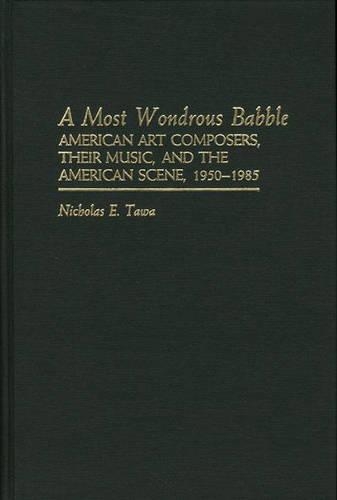
A Most Wondrous Babble: American Art Composers, Their Music, and the American Scene 1950-1985
(Hardback)
Publishing Details
A Most Wondrous Babble: American Art Composers, Their Music, and the American Scene 1950-1985
By (Author) Nicholas E. Tawa
Bloomsbury Publishing PLC
Praeger Publishers Inc
15th May 1987
United States
Classifications
Tertiary Education
Non Fiction
780.973
Physical Properties
Hardback
297
Description
Tawa considers the musical and social ramifications influencing the American composer between 1950 and 1985. He draws information from composers, music reviewers, and from his own listening experiences. Tawa's common theme is the gulf between what the composer (or critic) says about the music and how the public experiences it. . . . More than 50 composers are considered. . . . Tawa . . . goes beyond biographical detail to help the reader to `understand the reasons for the deep abyss separating contemporary composer and listener'. Choice The decades following World War II witnessed an explosion of musical creativity in America. Unfortunately, they also witnessed a widening abyss between the contemporary composer and his or her audience. Confusion on the part of the modern listener is an all-too-frequent phenomenon when he or she is confronted by the extraordinary profusion of contemporary musical styles. This useful volume is intended to relieve some of that confusion. Insightful commentaries and a highly readable text combine to focus on all contemporary musical styles from the most traditional to the most experimental in relation to modern American life. Taking the position that music is a transaction between creator/composer and listener, the author considers ways in which each faction may become more aware of the other's imperatives, thereby sponsoring a new and mutually meaningful music.
Reviews
Tawa considers the musical and social ramifications influencing the American composer between 1950 and 1985. He draws information from composers, music reviewers, and from his own listening experiences. Tawa's common theme is the gulf between what the composer (or critic) says about the music and how the public experiences it. He looks at the artistic turmoil of post-WW II, electronic sound, serialism, atonality, ethnic sources, and the traditional mainstream and its more venturesome composers. In a final essay, Reconciliations, ' Tawa advises the composer to cease isolation, to reconsider the use and function of music, to once again achieve a sense of community with a society in which he expresses faith, while not spurning tradition. More than 50 composers are considered.... Tawa ... goes beyond biographical detail to help the reader understand the reasons for the deep abyss separating contemporary composer and listener.' Extensive discography and selective bibliography. Devoid of actual analysis of compositional styles, the book is appropriate for upper-division and graduate students, and for general readers.-Choice
"Tawa considers the musical and social ramifications influencing the American composer between 1950 and 1985. He draws information from composers, music reviewers, and from his own listening experiences. Tawa's common theme is the gulf between what the composer (or critic) says about the music and how the public experiences it. He looks at the artistic turmoil of post-WW II, electronic sound, serialism, atonality, ethnic sources, and the traditional mainstream and its more venturesome composers. In a final essay, Reconciliations, ' Tawa advises the composer to cease isolation, to reconsider the use and function of music, to once again achieve a sense of community with a society in which he expresses faith, while not spurning tradition. More than 50 composers are considered.... Tawa ... goes beyond biographical detail to help the reader understand the reasons for the deep abyss separating contemporary composer and listener.' Extensive discography and selective bibliography. Devoid of actual analysis of compositional styles, the book is appropriate for upper-division and graduate students, and for general readers."-Choice
Author Bio
NICHOLAS E. TAWA is Professor of Music at the University of Massachusetts in Boston.
